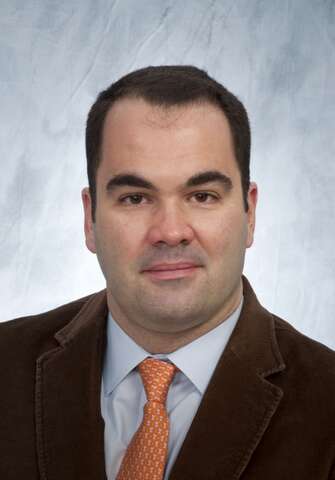Faculty Focus - Leo da Costa

Leo da Costa, MD
Dr. da Costa received his MD from the Federal University of Minas Gerais, Brazil, in 1995 and finished his neurosurgical training in 2000, also in Brazil. He completed four years of fellowship training at the University of Toronto from 2004 to 2008, including 3 years of Cerebrovascular Surgery and Interventional Neuroradiology. He joined the Division of Neurosurgery as an Assistant Professor in September 2008 and currently works at Sunnybrook Health Sciences Centre, where he holds positions in the Division of Neurosurgery and the Department of Medical Imaging. His major interests are carotid disease and stroke prevention interventions and regulation of cerebral blood flow/vasospasm after injury/subarachnoid hemorrhage. Dr. da Costa is married to Christianne Werneck, a vascular surgeon and Assistant Professor in the University of Toronto Department of Surgery at Trillium Hospital. They have a son, Bernardo, who is 2 1/2 years old.
Peer-Reviewed, Funded Grants
- Canadian Institutes of Health Research (CIHR), 2011 Jul-2014 Jun.
Optical Coherence Tomography for Intraoperative Imaging During Skull Base Neurosurgical Procedures.
Victor Yang (lead), Michael Cusimano, Leodante da Costa, Beau Standish.
$134,200 - Physicians Services Incorporated Foundation (PSI), 2011 Jul-2013 Jun. Catecholamines as outcome markers in traumatic brain injury study COMA in TBI study.
Sandro Rizzoli (lead), Capone, A; Rubenfeld, G; da Costa, L; Topolovec-Vranic, J; Chapman, M; Shawn, R.
$162,500 - Canadian Stroke Network (CSN), 2010.
Symptomatic carotid stenosis revascularization - What’s the hold up?
Leodante da Costa
$7,000
Selected Peer-Reviewed Publications
- da Costa, L; Dehdashti, A.R; ter Brugge, G. Spinal cord arteriovenous shunts: spinal arteriovenous malformations and dural fistulas. Neurosurgical Focus. 2009: 26(1): pp E6.
- da Costa, L; Wallace, MC; ter Brugge, K; O’Kelly, C; Willinsky, RA; Tymianski, M. The Natural History and Predictive Features of Hemorrhage from Brain Arteriovenous Malformations. Stroke. 2009: 40: pp 100-105.
- Dehdashti AR; da Costa, L; terBrugge KG; Willinsky RA; Tyminaski M; Wallace MC. Overview of the current role of endovascular and surgical treatment in spinal dural arteriovenous fistulas. Neurosurgical Focus. 2009: 26(1): pp E8.
- Willinsky, RA; Peltz, J; da Costa, L; Agid, R; Farb, R.I; ter Brugge, K. Clinical and angiographic follow-up of ruptured intracranial aneurysms treated with endovascular embolization. American Journal of Neuroradiology. 2009: 30: pp 1035-1040.
- Thines, L; Agid, R; Dehdashti A.R; da Costa, L; Wallace, M.C; ter Brugge, K.G; Tymianski, M. Assessment of extracranial-intracranial bypass patency with 64-slice multi-detector computerized tomography angiography. Neuroradiology. 2009: 51: pp 505-515.
- Marotta, TR; Gunnarsson T; Penn, Ian; Ricci, DR; McDougall, I; Marko, A; Bourne, G; da Costa, L. Endovascular Clip Systems (eCLIPsTM): a novel endovascular device for treatment of intracranial aneurysms technology, concept, and initial experimental results. Journal of Neurosurgery. 2008: 108: pp 1230-1240.
- da Costa, L; Thines, L; Dehdashti, A.R; Wallace, M.C; Willinsky, R; Schwartz, M; Tymianski, M; ter Brugge, KG. Management and clinical outcome of posterior fossa arteriovenous malformations report on a single center 15 years experience. Journal of Neurorology, Neurosurgery and Psychiatry. 2008: 80: pp 376-379.
- da Costa, LB; terBrugge K; Wallace MC. Surgical disconnection of cortical venous reflux as a treatment for Borden type II dural arteriovenous fistulae. Acta Neurochirurgica. 2007: 149: pp 1103-1108.
- Costa Jr, LB; Gunnarsson T; Wallace MC. Unruptured intracranial aneurysms: natural history and management decisions. Neurosurgical Focus. 2004: 17(5): pp 1-6.
- Thines, L; Dehdashti, AR; da Costa, L; Tymianski, M; ter Brugge, KG; Willinsky, RA; Schwartz, M; Wallace, MC. Challenges in the management of ruptured and unruptured brainstem arteriovenous malformations: outcome after conservative, single modality or multimodality treatments. Neurosurgery, in press.
